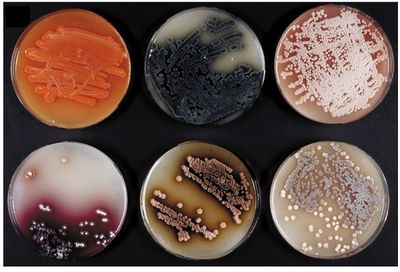Streptomyces is the largest genus of the Actinobacteria with over 500 known species, belonging to the family Streptomycetaceae. They are found predominantly in soil and decaying vegetation. They are gram positive and have a mycelium-type growth resembling molds. The DNA has a high G-C content.
Most Streptomyces produce spores, and they are noted for the “earthy” odor following a rain because of the production of the volatile compound geosmin.
Streptomyces is the largest antibiotic producing genus in the microbial world. The estimated number of secondary antimicrobial compounds produced by this genus is estimated to be about 100,000. These include antifungals, antibiotics and chemotherapeutic chemicals.
Search of the National Library of Medicine via entrez pubmed gave a list of 7,683 published research papers on the subject of Streptomyces + antibiotics. The identification and production of antimicrobial compounds produced by this genus began in the 1970s and continues to current. The antimicrobial compounds currently or formerly in use will be briefly reviewed below.
Following this review, the presence of various species of Streptomyces in damp indoor spaces will be discussed.
Antifungals from Streptomyces species
Streptomyces produce numerous antifungal compounds which belong to the polyene antimycotics. Polyene antimycotics, sometimes referred to as polyene antibiotics, are a class of antimicrobial compounds targeting molds.
The polyenes bind to ergosterol in the fungal cell membrane and promote leakiness which may contribute to fungal cell death. Their chemical structural feature is a large ring of atoms (essentially a cyclic ester ring) containing multiple conjugated carbon-carbon double bonds (hence polyene) on one side of the ring and multiple hydroxl groups bonded to the other side of the ring. Their structures often have a d-mycosamine (a type of amino-glycoside) group bonded to the molecule.
The series of conjugated double bonds typically absorbs strongly in the ultraviolet-visible region of the electromagnetic spectrum, often resulting in the polyene antibiotics having a yellow color.
Examples of polyene antifungals are Nystatin (S. noursei), Amphotericin B (S. nodosus) and Natamycin (S. natlensis).
Antibiotics from Streptomyces species
Streptomyces species are the source of a large number of antibiotics. As mentioned above, over 7500 research papers have been published on this subject. The most frequently used and medically important antibiotics are:
Eryrthromycin (S. fradiae)
Neomycin (S. griseus)
Streptomycin (S. rimosus)
Tetracycline (S. Rimosus)
Vancomycin (S. Orientals)
Daptomycin (S. Rosesporus)
Rifamycin (S. mediterranei)
Chloramphenicol (S. venezuelae)
Puromycin (S. alboniger)
Lincomycin (S. lincolnensis)
Cefoxin (S. lactamdurans)
Chemotherapeutic Chemicals from Streptomyces species
Anthracyclines were the subject of cancer treatment since the 1970s. The daunosamine and tetra-hydronaphthacenedione-based compounds are cell-cycle nonspecific and are used to treat a large number of cancers including lymphomas and leukemia and uterine, ovarian, lung and breast cancers.
Anthracyclines drugs are developed from natural resources.
Daunorubicin was discovered by isolating it from soil-dwelling fungus Streptomyres.
Doxorubicini which is another commonly used anthracycline chemotherapy agent, is isolated from mutated strain of Streptomyces.
Although both the drugs have similar mechanisms, doxorubicin is more effective in treating solid tumors, Idarubicinf Epirubicin, and Mitoxantrone are other commonly used anthracycline chemotherapy drugs.
Anthracyclines work by forming free radicals that break DNA strands thereby inhibiting DNA synthesis and function. These chemotherapeutic agents form a complex with DNA and enzyme to inhibit the topoisomerase enzyme. Topoisomerases are enzymes that causes the supercoiling of DNA, allowing DNA repair, transcription and replication.
Cardiac toxicity is a serious side effect of anthracyclines as heart muscle can be damaged. The various chemotherapeutic compounds are produced by the following Streptornyces Streptomyces gtiseus, var. rubidofaciens (Daunorubkn), Streptomyces peucetius (doxorubkin) and Streptomyces iividans TK24 (produces daunomycin to doxorubicin).
